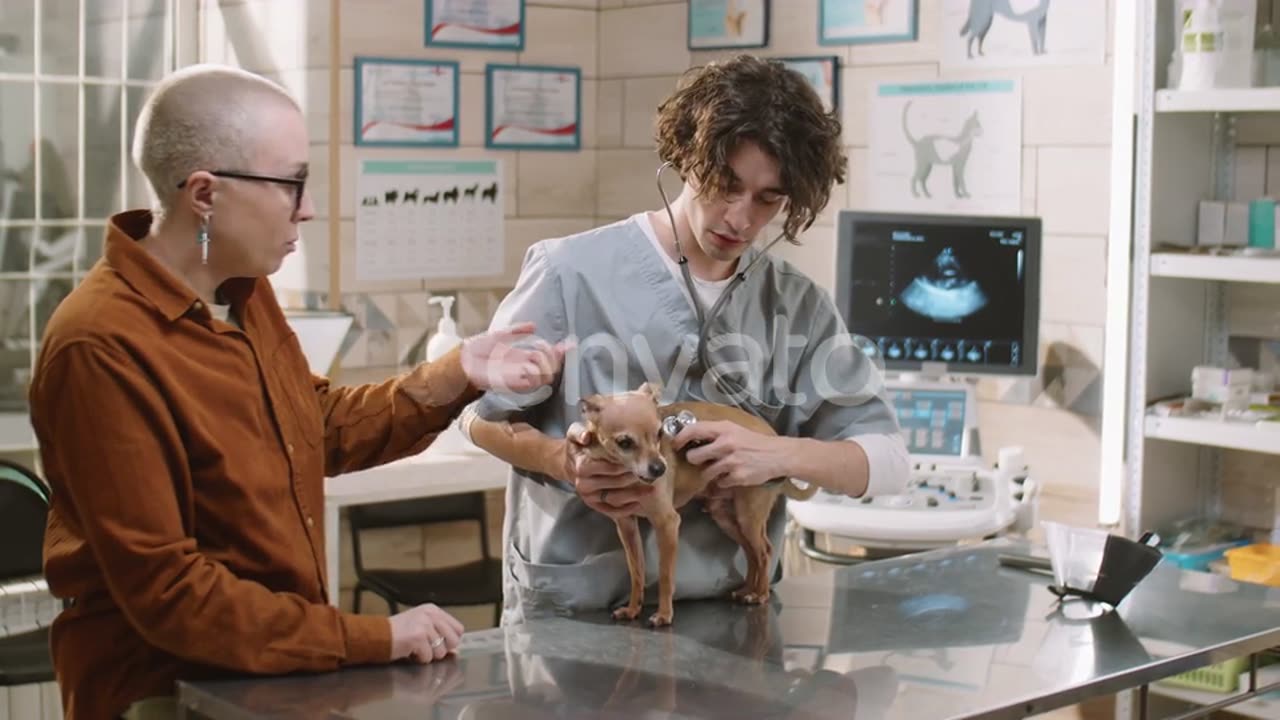Premium Only Content

Veterinarian Giving Checkup to Dog in Clinic
@doghelp
As a veterinarian, when giving a checkup to a dog in a clinic, there are several steps you would typically follow to ensure a thorough examination. Here's an outline of the process:
1. Greeting and history: Begin by greeting the dog and establishing a rapport with both the pet and the owner. Take the opportunity to gather relevant information about the dog's medical history, current concerns, and any changes in behavior or appetite.
2. Physical examination:
a. Vital signs: Start by measuring the dog's vital signs, including temperature, heart rate, and respiratory rate.
b. General observation: Observe the dog's overall appearance, posture, and behavior for any signs of distress, pain, or discomfort.
c. Eyes, ears, and nose: Examine the dog's eyes for clarity, redness, or discharge. Check the ears for signs of infection, inflammation, or excessive wax. Inspect the nose for discharge, abnormalities, or difficulty breathing.
d. Oral examination: Inspect the dog's teeth, gums, and tongue for any signs of dental disease, tartar buildup, or oral lesions.
e. Skin and coat: Check the skin for rashes, lesions, parasites, lumps, or signs of allergies. Inspect the coat for its overall condition, presence of fleas or ticks, and signs of hair loss or matting.
f. Musculoskeletal system: Examine the dog's limbs, joints, and spine for any signs of pain, lameness, swelling, or abnormalities in movement.
g. Abdominal examination: Palpate the dog's abdomen to assess the size and condition of internal organs and check for any signs of discomfort or pain.
h. Lymph nodes: Feel the lymph nodes in the dog's neck, armpits, and groin area to detect any swelling or abnormalities.
i. Heart and lungs: Use a stethoscope to listen to the dog's heart and lungs, assessing for any irregularities, abnormal sounds, or difficulty breathing.
j. Rectal examination: In some cases, a rectal examination may be necessary to check the dog's anal glands, assess the rectum, and look for signs of internal issues.
3. Additional tests: Depending on the dog's history, symptoms, or findings during the physical examination, you may recommend further tests such as blood work, urine analysis, fecal examination, X-rays, or ultrasound to gain more insights into the dog's health.
4. Discussion and recommendations: Once the examination is complete, discuss the findings with the owner. Provide any necessary explanations, address their concerns, and answer any questions they may have. Based on the examination results, provide recommendations for further treatment, preventive care, or lifestyle modifications if needed.
Remember, this is a general overview of a checkup, and specific procedures may vary depending on the individual dog's needs and the veterinarian's clinical judgment.
-

BonginoReport
2 hours agoNYC Chooses Socialist Mayoral Candidate - Nightly Scroll w/ Hayley Caronia (Ep.77) - 06/25/2025
29.3K25 -
 1:15:24
1:15:24
Kim Iversen
3 hours agoMamdani Wins: Red Scare, or Red, White and Blue Wake-Up Call?
24.6K39 -
 LIVE
LIVE
Akademiks
2 hours agoDiddy Trial Day 30: Prosecutor Drops Bombshell. REMOVES Several Charges from Diddy before JURY. 2/30
2,027 watching -
 LIVE
LIVE
The Mike Schwartz Show
1 hour agoTHE MIKE SCHWARTZ SHOW Evening Edition 06-25-2025
143 watching -
 58:06
58:06
Sarah Westall
2 hours agoTectonic Shifts of Influence: – Power Structures are being Rewritten w/ Sam Anthony
12K -
 LIVE
LIVE
LFA TV
22 hours agoLFA TV ALL DAY STREAM - WEDNESDAY 6/25/25
740 watching -
 1:11:05
1:11:05
TheCrucible
2 hours agoThe Extravaganza! EP: 11 with Guest Co-Host: Made By JimBob (6/25/25)
77.6K13 -
 52:26
52:26
MYLUNCHBREAK CHANNEL PAGE
1 day agoAngels Built the Old World?
10.3K28 -
 53:24
53:24
Nicholas Bowling
3 hours ago $0.05 earnedStreet Preaching at Anti-Trump "No Kings" Protest!
668 -
 1:26:06
1:26:06
Redacted News
3 hours agoHIGH ALERT! NATO GLOBALISTS PUSHING WAR WITH PUTIN USING FALSE FLAGS, COL. MACGREGOR LIVE | REDACTED
127K104